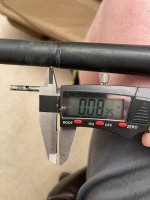Put together a new .308 gas gun a few weeks ago and I'm having a hell of a time getting the gas system running. Thought I'd see if anyone here has faced a similar issue. The components are as follows:
LaRue 16" Midlength Barrel
Superlative Arms Adjustable Gas Block
Melonited Mid-Length Gas Tube
I've assembled a lot of gas guns over the years and have never had this much trouble with a gas system. I installed everything and test fired only to seemingly get no gas to the bolt. So, I disassembled and the reassembled with the same result. I'm wondering if it is an issue with the gas block or gas tube. I have a new gas tube coming to see if that fixes things. I used the spaghetti trick to make sure the gas hole is lined up with the gas block.
This is the first time I've tried a SA adjustable block, so I'm not sure if there is a defect with the gas block. I set it up per the instructions, but I don't know if I might also be doing something wrong. I guess I can replace the gas block with a standard one as well to make sure it's not a barrel or bolt issue.
Anyone have suggestions or other obvious things I might be missing?
LaRue 16" Midlength Barrel
Superlative Arms Adjustable Gas Block
Melonited Mid-Length Gas Tube
I've assembled a lot of gas guns over the years and have never had this much trouble with a gas system. I installed everything and test fired only to seemingly get no gas to the bolt. So, I disassembled and the reassembled with the same result. I'm wondering if it is an issue with the gas block or gas tube. I have a new gas tube coming to see if that fixes things. I used the spaghetti trick to make sure the gas hole is lined up with the gas block.
This is the first time I've tried a SA adjustable block, so I'm not sure if there is a defect with the gas block. I set it up per the instructions, but I don't know if I might also be doing something wrong. I guess I can replace the gas block with a standard one as well to make sure it's not a barrel or bolt issue.
Anyone have suggestions or other obvious things I might be missing?



